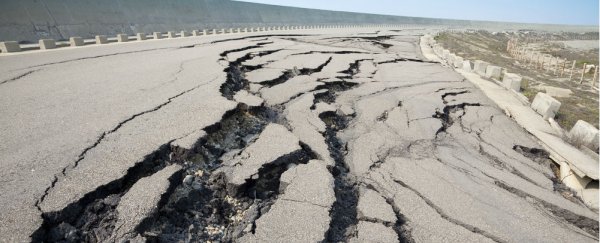Scientists have confirmed that two California fault lines - the Calaveras Fault and the Hayward Fault - are connected, meaning earthquakes resulting from ground movement in these zones could be larger and more destructive than originally thought.
The team from the University of California, Berkeley says the 70-km-long Hayward Fault is "already known as one of the most dangerous in the country because it runs through large population areas." The line begins near Santa Rosa in the north, passes east of San Francisco, and ends near San Jose in the south.
And now that they know it's connected to the 123-km-long Calaveras Fault, they say the risk it poses could be even greater.
"The maximum earthquake on a fault is proportional to its length, so by having the two directly connected, we can have a rupture propagating across from one to the other, making a larger quake," said lead researcher and seismologist, Estelle Chaussard, in a press release.
In an update of seismic hazards last month, the US Geological Survey estimated a 14.3 percent likelihood of a magnitude 6.7 or greater earthquake on the Hayward Fault in the next 30 years, and a 7.4 percent chance of a similar earthquake on the Calaveras Fault. But the researchers say these estimates were based on the assumption that the two fault systems were independent.
"We thought we could have a magnitude 6.9 earthquake. Now that the two fault lines are connected, we could have magnitude 7+ earthquakes, 7.3 or even larger depending on where the rupture goes," Chaussard told Michele Berger at The Weather Channel.
"Going from a magnitude 6.9 to a magnitude 7.3, that's 2.5 times the amount of energy released. We have to expect that we could have larger shaking earthquakes than we previously thought."
Researchers have previously suspected that the two faults were connected, but were never able to show this definitively.
The team used two decades worth of data from the European Space Agency's ERS and Envisat satellites to measure ground deformations and creep along the southern end of the Hayward Fault. 'Creeping' refers to very subtle but continuous movement at the surface.
They found that the creep didn't stop at the presumed southern end of the fault, but continued for another 15 kilometres, ultimately merging with the Calaveras Fault.
The researchers say this extension was previously hidden by vegetation covering the ground.
In addition to their aerial data, seismic tests show that micro-earthquakes on these faults between 3 and 5 kilometres underground also merge.
"With this evidence from surface creep and seismicity, we can argue for a direct junction on the surface and at depth for the two faults," said Chaussard."People have been looking for evidence of this for a long time, but only now do we have the data to prove it."
The team has reported its findings in the journal Geophysical Research Letters, and they say the next stage of the research is to refine their "magnitude estimates" for specific spots along the fault line to help predict potential damage.
Sources: The Weather Channel
